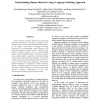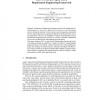4250 search results - page 20 / 850 » Understanding the Requirements on Modelling Techniques |
IIHMSP
2006
IEEE
14 years 1 months ago
2006
IEEE
Visual analysis of human behavior has generated considerable interest in the field of computer vision because of the wide spectrum of potential applications. In this paper, we pre...
CAISE
2009
Springer
14 years 2 months ago
2009
Springer
Advantages and shortcomings of different process modeling languages are heavily debated, both in academia and industry, but little evidence is presented to support judgements. Wit...
PAMI
2010
13 years 6 months ago
2010
—Facial expression is a natural and powerful means of human communication. Recognizing spontaneous facial actions, however, is very challenging due to subtle facial deformation, ...
RE
2006
Springer
13 years 7 months ago
2006
Springer
Literature tends to discuss software (and system) requirements quality control, which includes validation and verification, as a heterogeneous process using a great variety of rel...
ER
2003
Springer
14 years 25 days ago
2003
Springer
Abstract. Requirements Engineering techniques, based on the fundamental notions of agency, i.e., Agent, Goal, and Intentional Dependency, have been recognized as having the potenti...


